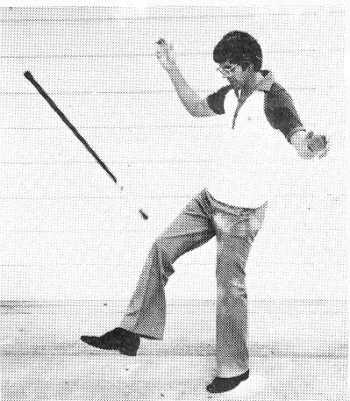 |

The author (above) submitted these illustrations to demonstrate some conventional and unorthodox tricks. |
Page 10 October 1980
HOW TO DO W. C. FIELDS STICK TRICKS
By James Clayton Lakeland, FL
 |

The author (above) submitted these illustrations to demonstrate some conventional and unorthodox tricks. |
|
Several
years ago I bought a home movie of W.C. Field's "The Great
McGonigle." Viewing it, I became intrigued with Fields' stick
manipulations. Ever since then, I've been doing everything from
entertaining at parties to trying to set a world record for
consecutive toe flips on the "Guiness Game" TV show. (More
on Clayton's dealings with Guiness below). I'd like to pass along what
I've learned. First
of all, you can get a copy of the Fields movie for Super 8 mm
projectors from: Universal 8 Films, 445 Park Ave., NY, NY 10022. Last
year the blackand-white, silent version cost $11 plus $2.50
postage and handling, but prices may have risen. The
main thing you need, of course, is a stick. Fields
did his tricks with what appears to be a simple wooden dowel. However,
I find through experience that a lighter stick is more desirable.
(Doing repeated toe flips with a wooden dowel can give you nasty
bruises on the top of the foot!) I've found a plastic pipe with rubber
tips to be best. The plastic makes the stick lighter, a definite
advantage, and the tips aid in executing many of the tricks. Many hardware stores and most plumbing places have plastic pipe. Buy about 34 inches of halfinch PVC or three-quarter inch CPVC (hot and cold) pipe. Each should have an outside diameter of about seven-eights inch, which is what you're after. Hardware stores should also have rubber crutch or furniture tips. Get two seven-eights, # 19 tips with a recessed end and put one on each end of the stick. Tips should fit snugly or they'll slip off when you're doing certain tricks. A fold or two of paper placed on the end of the pipe under the tip will help make a tight fit if needed.
I
have a whole batch of sticks, made from a special run of seven-eights
inch black ABS plastic tubing with black rubber crutch tips. They're
cluttering my garage and I'll be glad to mail you one free if you'll
send postage enough to carry eight ounces from me to your home. My
address is 1715 Sanchez Ave., Lakeland, FL 33801. As
soon as you get a stick, you're ready to learn some tricks. Here are
six basic ones to work on, from the simple hand balance to the rather
difficult toe flip. 2.
Balance it on your finger with the arm extended overhead.
3.
Balance it on your chin.
4.
Balance it on your toe.
5.
Flip it a half-tum from a hand balance back to a hand balance.
6.
Flip it a half-tum from a toe balance back to a toe balance. A
variation of the hand balance is the hand to hand
jump. Give a short, quick push with one hand so the stick goes
straight up five or six inches. Then catch/balance it with the other
hand as it comes down.
Several things can be done from the finger balance. Withdraw the balancing finger quickly so the stick drops straight down and catch it with the palm of the other hand, which is waiting for it waist high. Or, move the withdrawn hand quickly down to catch the stick as it falls. Or, let it drop straight on the floor, bounce up and grab it on the bounce. Finally, transfer it to your thumb while the arm is still extended and transfer it from there to your chin for a chin balance.
To
come out of the chin balance, you may lower your head quickly so that
the stick hits and slides off
your shoulder. Grab it as it shoots forward. Or, give a quick upward
head jerk to let the stick drop straight down into your hand. To go into the toe balance, Fields held the top of the stick and simply dropped it about six inches into a catch/balance on the toe. Or you can catch/ balance it as it bounces off the floor. From a hand balance position, you should lean slightly forward, and lower your hand to within about a foot of your raised foot. Quickly drop the hand away and catch/ balance it with your toe. Reversing this, you can jerk your leg up to make a pass from the toe to the hand.
Variations
of the hand flip include catching it with the other hand, flipping it a
complete revolution instead of a half-tum and doing a half-flip with a
hat on the top of the stick. As it turns, the hat comes off. You catch
the hat in one hand and the stick in the other.
The
right kind of shoes make the difficult toe flip easier. I wear well
broken-in, plain-toed leather shoes. They offer a wider, unobstructed,
soft area on which to make the catch/balance. Toes too hard will cause
the stick to bounce off. Laces or seams on or near the toe make it
difficult to successfully complete the flip.
One
of Fields' toe flip variations was to flip from one foot to the other.
This is a tough trick to learn, but this hint may help: Move the
balancing foot in toward the other foot, to a center line of your body.
Bend the other knee slightly and push your body up with that leg as you
make the flip with the other.
Caution!!
Repeated jumping from one foot to the other can hurt your knees (I speak
from experience!). With enough practice, you could keep flipping the
stick back and forth from foot to foot. If you make a stick, try out
some tricks and decide that flipping is not your forte...don't despair!
There are hundreds of other uses for the stick. |